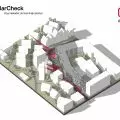Review from A&B issue04|2023
It started with the thought that about 40 centimeters of a building wall changes our perception when it comes to looking at space in a multifaceted way. Even in our own home. What we call home inside, what we call outside—well, what? And after all, it is also our property, our home. Treating what's outside the building, on the „outside,” in a low-key manner is the norm.
This applies to both public, commercial and private facilities. For me, the best example of such a view is a question I repeatedly ask during lectures: What if, when you walked into the living room of your newly built house, you saw one of the construction workers throwing garbage under the floor, ordinary construction waste, just before the screeding was done? Most of the interviewees answer: Well, what do you mean? An avowal. Then I ask: Then why don't we make such a row when during construction work garbage and waste lands under the surface of the floor of a garden or green area?
In my opinion, this is one of the best examples that confirm our view of the outdoor space. She is somehow not ours. The second thing that comes to mind is function. What's inside, each room, has a clearly defined function. Living room, office, kitchen or garage. We know this practically from the beginning, already at the design stage. Meanwhile, „to make it pretty” is in most cases the only function of a garden or public space. Pretty is, of course, a relative term. But let's get back to function. If we don't give an outdoor space a function and leave it only „pretty,” it will quite quickly become boring to the public and we will either sneak past it without thinking, or—as in the case of public areas—it will simply become neglected and dilapidated. And even though we spend millions on materials and this „nice” of ours, nothing will come of it. I compare it to buying an expensive painting: when we hang it on the wall, we walk around and cmoco. After a month, however, it becomes just a background in a living room space that has a function.
The function of the space, but not just a standard one like communication or the ability to sit on a bench, is badly needed. A function that is thoughtful, unrestricted and concrete. By the way, we should learn from other nations the skill and multi-functionality of using green spaces. For the purpose of promoting function in green space design, I have coined the slogan „A garden is also a house,” that is, the function of what is inside is to intermingle and complement the function of what is outside. This does not apply only to private homes, it should also be the domain of commercial and public spaces.
Functional space, not just „green” space
© Filipowski
One building that has translated this premise into practice is the Green Lecture Hall pocket park realized in Lublin. As a curiosity, I'd like to add that it was created in the Design, Build and Animate system—an addition to the classic Design and Build became animation for twelve months after implementation, so as to accustom users to the full range of possibilities for using the Hall. An exhibition system, a projection wall, a dance area or a gallery for one sculpture and a place to conduct workshops are the multifaceted functions of this space. We also made sure that this pocket park had aesthetic value. Does it work? Yes. Many lectures, presentations and meetings have been held there. Evenings with book authors, exhibitions, meetings for seniors and children—this is just a smattering of what went on there. The experience worked well until the pandemic hit. We are now rebuilding the animation system. If we want green areas or public spaces to be more respected, more „ours,” we need to look at them not as an addition to and emphasis on the qualities of the building, but as a full-fledged equivalent functional space. We can't put only a stylistic-aesthetic warp on the project, the function is also needed, and not just the basic one. Our joint role, architects and landscape architects, is to direct the space in this direction. First superimpose function on it, then put in, as in a building, good technologies, and only finally aesthetics and complementation from plant compositions that promote the realization of a full range of recreation or work. Plants, by the way, can also be given functions by taking advantage of their capabilities. From enhancing urban biodiversity and drawing on ecosystem services, to education, to simple fun.
The best example is this story: during one visit to a large foreign tree nursery, I saw a bunch of children with a guardian wandering toward a large clump of multi-trunk tall specimens. So I asked my guide what was this phenomenon? He replied quite normally: children from the elementary school had come to choose a tree to climb. What was my surprise, which naturally passed into joy and then into reflection. Children came to choose a tree to climb? When will this kind of thinking dawn on us, on the parents of outgrown children and on space designers?

















